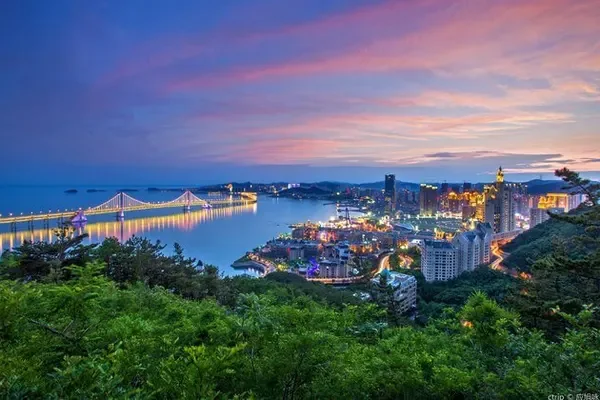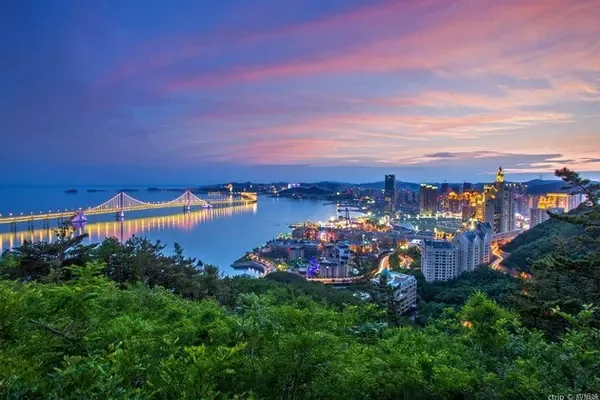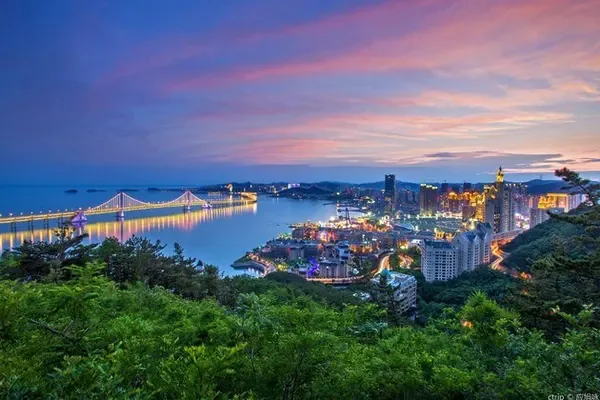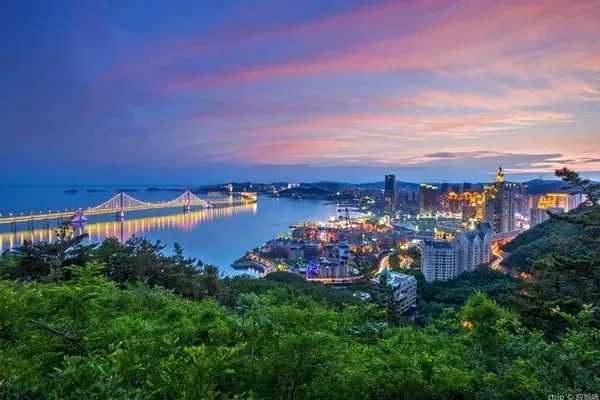★Tourist location: Guansuoling, Guanling County, Anshun, Guizhou
Guansuoling is a branch of Wumeng Mountain, referred to as Guanling for short, it is located on the west bank of Baling River, and Guanling County is named after it. Although the name of this ridge is unknown, Guanling Autonomous County was named after the ridge, which is quite attractive to us. What's more, the place where we live is not too far from Guan Suo Ridge.
Walking through the Lianhua Commercial Street, although the scale is not very large, we still walked in and walked around. It seems that this may be the bustling block of Guanling County, and many places are still being decorated, which may have been built with the relocation of the seat of the county government, and it has not yet been fully built. There are many shops on both sides of the street, which don't look like century-old shops, but there are many gourmet shops, and today's dinner is settled again.
There is a large lotus well at the entrance of the street, and there are six wells in the pavilion. Maybe the wells at the bottom are connected, but six wells were dug. There is a pavilion on the well, surrounded by railings. This pavilion also looks quite grand, with an antique style with double eaves. It is said that this well used to be one of the "Eight Views of Guansuo", commonly known as Dashui Well, or Lotus Well for short. Guansuo Town, the county seat, used to be called Liancheng. Maybe there is a poignant story? Probably there was a severe drought in Guanling in a certain year, and the lotus fairy couldn't bear the suffering of the people to suffer from the drought, so she attracted the sweet spring. Unexpectedly, this action angered the heavenly court, and the rulers such as the emperor of heaven or the queen mother committed crimes. In order to commemorate the lotus fairy, the common people named this well as the lotus well. Perhaps there is also a bloody war of resistance against local evil forces in order to protect the people. Of course, this is just what we made up in our brains. Because we were eager to go to Guansuoling, we said a few words casually, bought three bottles of mineral water in the supermarket, and started climbing.
The mountain road looks quite quaint, as if it hasn't been repaired with much effort. There is a stone tablet at the entrance, which says "The Ancient Tea Horse Road-Guizhou-Guansuoling Ancient Road". We were also quite surprised. It turned out that this place is still a section of the Ancient Tea Horse Road? It is said that since ancient times, this has been a key pass on the passage between Yunnan and Guizhou provinces. In the twenty-fifth year of the Republic of China, the Guizhou-Yunnan Highway was opened to traffic, and the historical mission of this ancient road was gradually terminated from the east foot south to the west waist of the mountain to the county seat.
The great traveler Xu Xiake once crossed Guansuo Ridge on foot, and described it in his travel notes. "It goes up to the ridge in the west, and then goes to the west, and there is another mile, and it is winding down to the southwest, very deep. At the beginning, I saw the distant peaks on the west boundary, from north to south, standing like a barrier, and the east boundary is sandwiched and opposed to each other; There is a stream in the middle, which also runs from north to south, and goes down to the bottom of the ravine..."
There is another monument next to it, engraved with the map of Guansuo Ridge. The total length of the hiking trail is 5.5 kilometers. Although the journey does not seem to be long, this section of the trail is a climbing trail and requires physical strength. However, the entrance we arrived at seems to be "closed feet". No wonder it doesn't look like a scenic spot. Have we reached the "end"?
The steps look like they have been around for some years, and they are by no means as neat as the fully developed scenic spots. Walking on the steps is still quite uneven. Said to be an ancient way, it seems that the age is still a bit old, but it is not very young. In Guizhou in June, the weather is very hot, even standing on the top of the mountain, there is no wind. Through the gaps in the woods, you can see the style and features of Guanling County. There are no tall buildings, and the houses with black tiles and white walls are in line with the mountains and trees.
Going forward along the stone steps, there is a very impressive building, which turned out to be the Royal Book Building. The building is two stories high and made of stone blocks. The bottom is in the style of a city gate, and the pillars on the second floor are wooden structures. This building was built in the early Ming Dynasty. It was named Yushulou because Emperor Kangxi wrote the plaque "Dianqian Lock and Key" in Qing Dynasty. The original building was destroyed by wildfires and rebuilt during the Guangxu period. The current characters are written by Sun Qingyan, a famous calligrapher and painter in Guizhou in the Qing Dynasty, imitating the style of Kangxi fonts. The square seal inscription on the upper right corner reads "Kangxi Second Year Pen" and the lower left corner reads "Chen Sun Qingyan worships the book". Later, the city tower was destroyed during the Cultural Revolution, and the building we see now was repaired by the Guanling County Government in 2019.
Speaking of Kangxi's handwriting, there is another story. Zhang Gun of the Qing Dynasty was a general and a calligrapher at the same time. He was ordered to march south, led his troops into the Yunnan-Guizhou Plateau, and guarded it for decades. One day he came to Guan Suo Ridge where he had fought, stood on Taizi Mountain, looked at the distant mountains and near mountains, and recalled his life as a soldier, he couldn't help being filled with emotion. Then I thought that my father and son were soldiers who were born and died, so I wrote down the words "a family of heroes". It is said that when the four characters were written, a vision was born, and the soldiers hung the plaque on the pavilion and corridor of Guansuoling. Later, a general guarding the Yunnan-Guizhou border road was recalled to Beijing. He saw this plaque on the way, and he was probably quite obsessed with calligraphy. Seeing these four dragon-flying and phoenix-dancing characters, he was like a treasure. When he saw the emperor, he Jin dedicated to Kangxi. Kangxi, who is an all-rounder in civil and military affairs, naturally knows the goods, and he also greatly appreciates these four characters. He also feels the loyalty of Zhang Gun's three generations of guarding the family and defending the country, so he wrote down the four characters "Dian Guizhou lock key". The local officials got the imperial pen, and naturally built the imperial book building non-stop, and hung this plaque. Of course, the legend is just a legend, and I don't know if there is any documented record. Thinking about it, although General Zhang is conceited, he would not have written "A Family of Heroes" by himself and hung it on the pavilion corridor. Stone carvings were popular in ancient times, so maybe the cliff carvings are left behind?
There are steps next to it to climb upstairs, but there is nothing upstairs, the door is closed, and it is estimated that the inside is also empty. The railings on the second floor are carved with patterns, and green grass grows in front of the railings.
There are several sections of city walls next to it, with lush vegetation. Maybe military projects were built here before? But now it looks very dilapidated, the wall has not collapsed, I don't know if it has been repaired later. A few stones were left on the ground, and there were lush grass and grass beside them.
From here, you can see the top of the mountain next to it. From the map, it may be the main peak of Guansuo Ridge, Prince Corridor. Since he is called the prince, there are naturally allusions that can be traced back. According to legend, when the Eight Sage Kings visited the south, they fell in love with a local village girl and had a son, who was the prince. Later, the virtuous king wanted to take the prince back to the imperial city, but the woman refused, so she hugged the prince and hid in the cave on the top of the mountain. The virtuous king accidentally set fire to the mountain, causing the mother and son to die in the sea of fire, so people called the place where the prince was born "Prince's Corridor". But we searched around and couldn't find a passable road, so we had to go back the same way. In fact, the steps here look quite old-fashioned, and they are probably some years old.




























